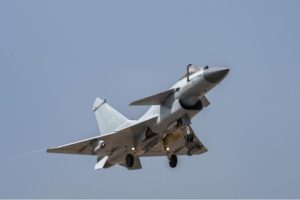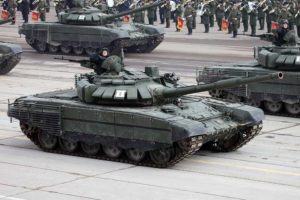
Russian Orthodox Church Strengthening Support for Ukraine Invasion
By Ray Finch
Given its close alignment with the Kremlin, it is not surprising that the Russian Orthodox Church (ROC) has adopted a “you are either with us or against us” philosophy and has openly endorsed the so-called “special military operation” (SMO) in Ukraine. (For additional background, see “Religious Blessing for the “Special Military Operation” in Ukraine,” OE Watch, May 2022).

Main Cathedral of the Russian Armed Forces.
“…It is worth recalling that shortly before the start of the special military operation of the Russian Federation in Ukraine, Hilarion said: “I am personally afraid of war. And I think that we must do everything to ensure that there is no war, no big war, no small war, no world war, no local war.”
Given its close alignment with the Kremlin, it is not surprising that the Russian Orthodox Church (ROC) has adopted a “you are either with us or against us” philosophy and has openly endorsed the so-called “special military operation” (SMO) in Ukraine. (For additional background, see “Religious Blessing for the “Special Military Operation” in Ukraine,” OE Watch, May 2022). The accompanying excerpt from the semi-independent Russian Nezavisimaya Gazeta describes some recent changes in the ROC’s hierarchy and organization, which reflects its growing militancy. The article begins by recounting the recent transfer of high-level ROC cleric Metropolitan Hilarion, who had spoken out against the conflict in Ukraine. Drawing an analogy to the collapse of the Russian Empire in 1917, Hilarion reminded his flock about “Rasputin [who] was an ardent opponent of Russia’s entry into the war. He warned the tsar that if Russia entered the war, it would threaten the whole country with catastrophic consequences.”
The article also provides an update regarding Orthodox believers in Ukraine who, up until last month, pledged allegiance to the Russian patriarch. They now have announced their intention to split from the ROC, which has caused consternation in Moscow. In the past, the clerics of the Ukrainian Orthodox Church of the Moscow Patriarchy (UOC-MP) enjoyed some level of independence from the church leadership in Moscow, but they will now fall under the “direct canonical and administrative subordination to the Patriarch of Moscow and All Russia and the Holy Synod of the Russian Orthodox Church.” The article also discusses the restoration “of protopresbyter of the military and naval clergy,” who will serve as the chief liaison between the ROC and the military. In the past, “this chief military priest was equated with a general.”
The growing proximity of the ROC and the military, according to the excerpt, “is not surprising. After the start of the invasion of Ukraine, the patriarch visited the main military church in Kubinka several times and delivered sermons there on the importance of military service.” These religious developments, whereby the ROC is losing influence in Ukraine, may provide additional incentives for the Kremlin to gain control over the entire country.
Source:
Andrei Melnikov, “РПЦ переходит на военное положение (The Russian Orthodox Church moves into martial law),” Nezavisimaya Gazeta (semi-independent Russian media outlet), 7 June 2022. https://www.ng.ru/faith/2022-06-07/1_8455_general.html
…The synod of the Russian Orthodox Church at a meeting on Tuesday put an end to the ambiguous position of the church against the backdrop of a military special operation in Ukraine. No longer bound by obligations to its Ukrainian believers, the Moscow Patriarchate is bringing its own configuration into line with the limits of influence of the Russian state. The synodals made revolutionary decisions: they removed Metropolitan Hilarion (Alfeev), who was responsible for “pacifism” in the Russian Orthodox Church, from the post of chairman of the Department for External Church Relations (DECR), and at the same time strengthened the spiritual and patriotic component of church policy….
…It is worth recalling that shortly before the start of the special military operation of the Russian Federation in Ukraine, Hilarion said: “I am personally afraid of war. And I think that we must do everything to ensure that there is no war, no big war, no small war, no world war, no local war. There are a lot of forces that want to drag us into some kind of war, and they are not only outside our country, but also inside it. There are those who want to rattle weapons, who say: they say, we are invincible, invincible, we will repulse any enemy. In March, he suddenly began to justify Grigory Rasputin. “Rasputin was an ardent opponent of Russia’s entry into the war. And he warned the tsar that if Russia entered the war, it would threaten the whole country with catastrophic consequences….”
The rejection of soft church power was also reflected in other decisions of the Synod of June 7. The ROC responded in a peculiar way to the recent declaration of independence by the Ukrainian Orthodox Church – mainly with the votes of those participants in the Council of the UOC on May 27, who are located on the territory of the country controlled by the Kyiv authorities. For a long time, starting from the Russian spring of 2014, the Moscow Patriarchate maintained demonstrative independence from the political situation and left the three eparchies of Crimea under the jurisdiction of the UOC.
In response to the appeals of His Grace Metropolitan Platon of Theodosius and Kerch, Metropolitan Lazar of Simferopol and Crimea, Bishop Alexy of Dzhankoy and Razdolnensky, proceeding from the need to maintain an effective canonical and administrative connection with the central church authorities for the successful flow of church life in the dioceses served by the aforementioned bishops, taking into account the practical the impossibility of regular communication of these dioceses with the Kievan Metropolia, to accept the Dzhankoy, Simferopol and Feodosiya eparchies into direct canonical and administrative subordination to the Patriarch of Moscow and All Russia and the Holy Synod of the Russian Orthodox Church, – says in synodal journals….
…Finally, the Synod, in a sense, turned history back: it restored the position of protopresbyter of the military and naval clergy, which had been abolished in 1918…. The chief military priest was equated with a general. ….
The attention of the Synod to the military theme is not surprising. After the start of the special operation in Ukraine, the patriarch visited the main military church in Kubinka several times and delivered sermons there on the importance of military service. It was these sermons that became the basis for calls for sanctions against the head of the Russian Orthodox Church, because he allegedly “blessed” the special operation in Ukraine.
Image Information:
Image: Main Cathedral of the Russian Armed Forces.
Source: https://en.wikipedia.org/wiki/Main_Cathedral_of_the_Russian_Armed_Forces
Attribution: CCA 4.0 Intl
Distribution A: Approved for public release
Categories:
Tags:
Related Products
Chinese Military Exercises Highlight Improvements in Joint Operations
North Korean Media Stays Quiet Despite Global Concerns
Russia Suspected of Distributing Former Syrian Military Assets To Mali






